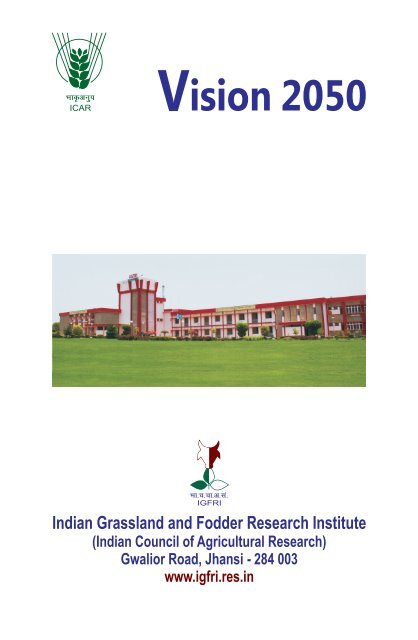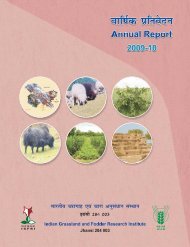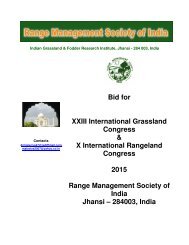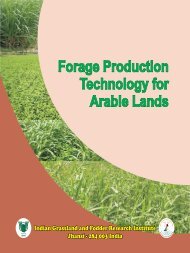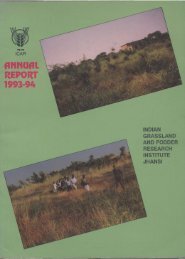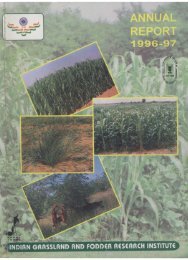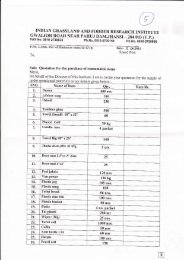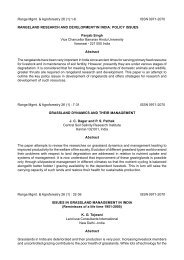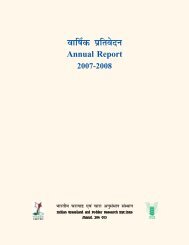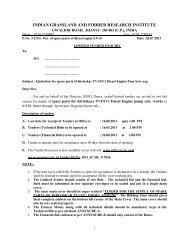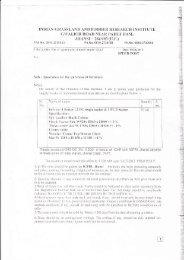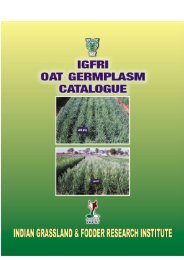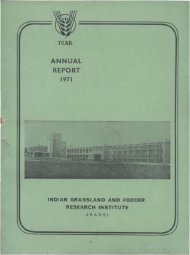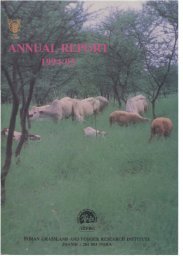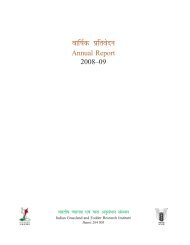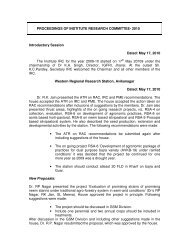IGFRI Vision 2050 - Indian Grassland and Fodder Research Institute ...
IGFRI Vision 2050 - Indian Grassland and Fodder Research Institute ...
IGFRI Vision 2050 - Indian Grassland and Fodder Research Institute ...
Create successful ePaper yourself
Turn your PDF publications into a flip-book with our unique Google optimized e-Paper software.
<strong>Vision</strong><br />
<strong>2050</strong><br />
<strong>Indian</strong> <strong>Grassl<strong>and</strong></strong> <strong>and</strong> <strong>Fodder</strong> <strong>Research</strong> <strong>Institute</strong><br />
(<strong>Indian</strong> Council of Agricultural <strong>Research</strong>)<br />
Gwalior Road, Jhansi - 284 003<br />
www.igfri.res.in
Ñf”k ,oa [kk| çlaLdj.k ea=h<br />
Hkkjr ljdkj<br />
MINISTER OF AGRICULTURE &<br />
FOOD PROCESSING INDUSTRIES<br />
GOVERNMENT OF INDIA<br />
‘kjn iokj<br />
SHARAD PAWAR<br />
MESSAGE<br />
The scientific <strong>and</strong> Technological inputs have been major drivers of growth <strong>and</strong><br />
development in agriculture <strong>and</strong> allied sectors that have enabled us to achieve<br />
self reliant food security with a reasonable degree of resilience even in times of<br />
natural calamities, in recent years. In the present times, agricultural<br />
development is faced with several challenges relating to state of natural<br />
resources, climate change, fragmentation <strong>and</strong> diversion of agricultural l<strong>and</strong> to<br />
non-agricultural uses, factor productivity, global trade <strong>and</strong> IPR regime. Some<br />
of these developments are taking place at much faster pace than ever before. In<br />
order to address these changes impacting agriculture <strong>and</strong> to remain globally<br />
competent, it is essential that our R&D institutes are able to foresee the<br />
challenges <strong>and</strong> formulate prioritised research programmes so that our<br />
agriculture is not constrained for want of technological interventions.<br />
It is a pleasure to see that <strong>Indian</strong> <strong>Grassl<strong>and</strong></strong> <strong>and</strong> <strong>Fodder</strong> <strong>Research</strong> <strong>Institute</strong><br />
(<strong>IGFRI</strong>), Jhansi, a constituent institution of <strong>Indian</strong> Council of Agricultural<br />
<strong>Research</strong> (ICAR) has prepared <strong>Vision</strong>-<strong>2050</strong> document. The document<br />
embodies a pragmatic assessment of the agricultural production <strong>and</strong> food<br />
dem<strong>and</strong> scenario by the year <strong>2050</strong>. Taking due cognizance of the rapidly<br />
evolving national <strong>and</strong> international agriculture, the institute, has drawn up its<br />
Strategic Framework, clearly identifying Goals <strong>and</strong> Approach.<br />
I wish <strong>IGFRI</strong> all success in realisation of the <strong>Vision</strong>-<strong>2050</strong>.<br />
(SHARAD PAWAR)<br />
Office : Room No. 120, Krishi Bhawan, New Delhi-110 001 Tel.: 23383370, 23782691 Fax : 23384129<br />
Resi. : 6, Janpath, New Delhi-110 001 (India) Tel. : 011-23018870, 23018619 Fax : 011-23018609<br />
E-mail : sharadpawar.sp@gmail.com
Mk- ,l- v¸;iu<br />
lfpo ,oa egkfuns’kd<br />
Dr. S. AYYAPPAN<br />
SECRETARY & DIRECTOR GENERAL<br />
FOREWORD<br />
Hkkjr ljdkj<br />
Ñf”k vuqla/kku vkSj f’k{kk foHkkx ,oa<br />
Hkkjrh; Ñf”k vuqla/kku ifj”kn<br />
Ñf”k ea=ky;] Ñf”k Hkou] ubZ fnYyh 110 114<br />
GOVERNMENT OF INDIA<br />
DEPARTMENT OF AGRICULTURAL RESEARCH & EDUCATION<br />
AND<br />
INDIAN COUNCIL OF AGRICULTURAL RESEARCH<br />
MINISTRY OF AGRICULTURE, KRISHI BHAWAN, NEW DELHI 110 114<br />
Tel.: 23382629, 23386711 Fax : 91-11-23384773<br />
E-mail : dg.icar@nic.in<br />
The <strong>Indian</strong> Council of Agricultural <strong>Research</strong>, since inception in the year 1929,<br />
is spreading science <strong>and</strong> technology led development in agriculture in the<br />
country. This is being accomplished through agricultural research, higher<br />
education <strong>and</strong> frontline extension undertaken by a network of research<br />
institute, agricultural universities <strong>and</strong> Krishi Vigyan Kendras. Besides<br />
developing <strong>and</strong> disseminating new technologies, ICAR has also been<br />
developing competent human resources to address the present <strong>and</strong> future<br />
requirements of agriculture in the country. Committed <strong>and</strong> dedicated efforts of<br />
ICAR have led to appreciable enhancement in productivity <strong>and</strong> production at<br />
a faster rate than the growth in dem<strong>and</strong>. This has enabled the country to<br />
become self-sufficient in food <strong>and</strong> emerge as a net food exporter. However,<br />
agriculture is now facing several challenges that are expected to become even<br />
more diverse <strong>and</strong> stiffer. Natural resources (both physical <strong>and</strong> biological) are<br />
deteriorating <strong>and</strong> getting depleted; risks associated with climate change are<br />
rising new forms of biotic <strong>and</strong> abiotic stress are emerging, production is<br />
becoming more energy intensive, <strong>and</strong> biosafety concerns are growing.<br />
Intellectual property rights <strong>and</strong> trade regulations impacting technology<br />
acquisition <strong>and</strong> transfer, declining preference for farm work, shrinking farm<br />
size <strong>and</strong> changes in dietary preferences are formidable challenges.<br />
These challenges call for a paradigm shift in our research approach to harness<br />
the potential of nodern science, innovations in technology generation <strong>and</strong><br />
delivery, <strong>and</strong> enabling policy <strong>and</strong> investment support. Some of the critical<br />
areas as genomics, molecular breeding, diagnosis <strong>and</strong> vaccines,<br />
nanotechnology, secondary agriculture, farm mechanization, energy<br />
efficiency, agri-incubators <strong>and</strong> technology dissemination need to be given<br />
priority. Multi-disciplinary <strong>and</strong> multi-institutional research will be of<br />
paramount importance, given the fact that technology generation is<br />
increasingly getting knowledge <strong>and</strong> capital intensive.<br />
It is an opportune time that the formulation of ‘<strong>Vision</strong>-<strong>2050</strong>’ by ICAR<br />
th<br />
institutions coincides with the launch of the national 12 Five Year Plan. In this<br />
Plan period, the ICAR has proposed to take several new initiatives in research,
education <strong>and</strong> frontline extension. These include creation of consortia research<br />
platforms in key areas, wherein besides the ICAR institutions, other science<br />
<strong>and</strong> development organizations would be participating; short term <strong>and</strong> focused<br />
research project through scheme of extramural grants; Agri-Innovation fund;<br />
Agri-incubation fund <strong>and</strong> Agri-tech Foresight Centres (ATFC) for research<br />
<strong>and</strong> technology generation. The innovative programme of the Council, ‘Farmer<br />
FIRST’ (Farmer’s farm, Innovations, Resources, Science <strong>and</strong> Technology) will<br />
focus on enriching knowledge <strong>and</strong> integrating technologies in the farmer’s<br />
conditions through enhanced farmer-scientist interface. The ‘Student<br />
READY’ (Rural Entrepreneurship <strong>and</strong> Awareness Development Yojana) <strong>and</strong><br />
‘ARYA’ (Attracting <strong>and</strong> Retaining Youth in Agriculture) are aimed to make<br />
agricultural education comprehensive for enhanced entrepreneurial skills of<br />
the agricultural graduates.<br />
I am happy to note that the <strong>Vision</strong>-<strong>2050</strong> document of <strong>Indian</strong> <strong>Grassl<strong>and</strong></strong><br />
<strong>and</strong> <strong>Fodder</strong> <strong>Research</strong> <strong>Institute</strong>, Jhansi has been prepared, based on the<br />
assessment of present situation, trends in various factors <strong>and</strong> changes in<br />
operating environment around agriculture to visulize the agricultural scenario<br />
about 40 years hence <strong>and</strong> chalk out a dem<strong>and</strong>-driven research agenda for<br />
science-led development of agriculture for food, nutrition, livelihood <strong>and</strong><br />
environmental security, with a human touch.<br />
I am sure that the ‘<strong>Vision</strong>-<strong>2050</strong>’ would be valuable in guiding our efforts in<br />
agricultural R&D to provide food <strong>and</strong> nutritional security to the billion plus<br />
population of the country for all times to come.<br />
Dated the 19th June, 2013<br />
New Delhi<br />
(S. Ayyappan)
PREFACE<br />
Livestock production <strong>and</strong> agriculture are complementary to<br />
each other <strong>and</strong> both are crucial for overall food security. India<br />
is gifted with the largest livestock population in the world. It<br />
accounts for about 57.3 per cent of the world's buffalo<br />
population <strong>and</strong> 14.7 per cent of the cattle population. There are about 71.6<br />
million sheep <strong>and</strong> 140.5 million goats in the country. Farmers of marginal, small<br />
<strong>and</strong> semi-medium operational holdings (area less than 4 ha) own about 87.7%<br />
of the livestock. Hence development of livestock sector would be more<br />
inclusive. The value of output from livestock sector at current prices was about<br />
Rs. 4, 59,051crore during 2011-12 which is about 24.8% of the value of output<br />
from total agricultural <strong>and</strong> allied sector at current price. The livestock sector<br />
achieved an average growth rate of 4.8 per cent during the Eleventh Five Year<br />
Plan (Economic Survey, 2012-13) <strong>and</strong> it contributed 3.6 percent of national<br />
GDP during the Eleventh Plan. India, the largest producer of milk in the world,<br />
is set to produce over 133 million tonne milk during 2012-13. The value of<br />
output of milk is Rs. 3,05,484 crore in 2011-12, which is higher than the value of<br />
output of paddy <strong>and</strong> wheat. The value of output from meat group in 2011-12<br />
was Rs. 83,641 crore. The Annual growth rate for production of milk is about<br />
5% in 2011-12 <strong>and</strong> 4.5% during the Eleventh Plan. The Livestock sector also<br />
contributes to export; total export earnings from livestock, poultry <strong>and</strong> related<br />
products were Rs. 33,417 crore during 2011-12.<br />
In arid <strong>and</strong> semi-arid regions, livestock is the only source of livelihood,<br />
particularly when crop fails to survive the drought. During the last two<br />
decades, studies in drought prone, distressed districts of Maharashtra,<br />
Karnataka <strong>and</strong> Andhra Pradesh have revealed that the incidences of farmers<br />
distress were mostly confined to families exclusively dependent on rainfed<br />
agriculture, while rural families dependent partly or fully on dairy husb<strong>and</strong>ry<br />
for their livelihood were able to face the stress successfully. Over the last two<br />
decades, dairy husb<strong>and</strong>ry has turned out to be the most reliable <strong>and</strong> primary<br />
source of livelihood for rural families living in rainfed areas. In spite of the<br />
importance of livestock, the productivity of our livestock has been extremely<br />
poor. While the average milk yield of cattle in the world <strong>and</strong> Europe is about<br />
2040 kg <strong>and</strong> 4250 kg per lactation respectively, the average milk yield of<br />
<strong>Indian</strong> cattle is about 1000 kg. While genetic improvement <strong>and</strong> health care<br />
are the prerequisites for sustainability, efficient feeding <strong>and</strong> marketing will<br />
help in increasing the profitability because 65-70% of the total cost of<br />
livestock farming is attributed to feeding. With feeding of good quality forage,<br />
particularly leguminous fodder, feeding of concentrate can be reduced<br />
significantly. With the increasing pressure on forage supply, small farmers are<br />
now shifting from large animals to small species like goats which depended on<br />
the common property resources (CPR) for free grazing. Over the last 3-4<br />
decades, there has been a steady increase in the growth of goat population as<br />
compared to that of large animals. If this shifting continues, it will accelerate
the pressure on the common property resources. There is no shortcut to sustain<br />
livestock husb<strong>and</strong>ry, without focusing the issues related to the development of<br />
fodder <strong>and</strong> feed resources in the country. At present, the country faces a net<br />
deficit of 35.6% green fodder, 10.95% dry crop residues <strong>and</strong> 44%<br />
concentrate feed ingredients. The dem<strong>and</strong> of green <strong>and</strong> dry fodder will reach to<br />
1012 <strong>and</strong> 631 million tonnes of by the year <strong>2050</strong>. At the current level of growth<br />
in forage resources, there will be 18.4 % deficit in green fodder <strong>and</strong> 13.2%<br />
deficit in dry fodder in the year <strong>2050</strong>. To meet out the deficit, green forage<br />
supply has to grow at 1.69% annually.<br />
Scientists of <strong>Indian</strong> <strong>Grassl<strong>and</strong></strong> <strong>and</strong> <strong>Fodder</strong> <strong>Research</strong> <strong>Institute</strong> joined h<strong>and</strong>s<br />
to produce a vision that would guide the development of national forage<br />
production in the years to come. The <strong>Vision</strong>-<strong>2050</strong> has been prepared based on<br />
the basic structure of <strong>Vision</strong>-2020 <strong>and</strong> <strong>Vision</strong> 2030 <strong>and</strong> keeping in mind the<br />
recent developments in forage science. This visioning process has unleashed<br />
among the <strong>IGFRI</strong> scientist an increased vigour <strong>and</strong> resolve, <strong>and</strong> indeed, a new<br />
sense of hope for a better future. We have, all of us, put together a document<br />
that aptly captures our dreams <strong>and</strong> aspirations, <strong>and</strong> maps out the way forward<br />
in the improvement of livestock <strong>and</strong> their owners. Our <strong>Vision</strong> Document<br />
presents a broad perspective framework of how <strong>IGFRI</strong> fraternity would like to<br />
see their country, especially the livestock sector, by the year <strong>2050</strong>. The <strong>Vision</strong><br />
provides a beacon towards which national energies <strong>and</strong> resources can be<br />
mobilized. It also facilitates development of country's forage production on a<br />
sustained basis. This document is also a product of discussions with scientists<br />
from diverse disciplines. Consultations are also done at the Council level. In a<br />
nutshell, this document truly reflects the wishes <strong>and</strong> aspirations of <strong>IGFRI</strong><br />
scientists. Most important of all, the <strong>Indian</strong> Council of Agriculture <strong>Research</strong><br />
has adopted this document as the framework within which all future forage<br />
research projects <strong>and</strong> development programmes will be formulated.<br />
<strong>IGFRI</strong> <strong>Vision</strong> <strong>2050</strong> document identifies seven pillars of forage<br />
development. These are genetic enhancement <strong>and</strong> forage cultivar/variety<br />
development, management of resources to enhance forage productivity,<br />
development of seed st<strong>and</strong>ard <strong>and</strong> seed production technology, farm<br />
mechanization for efficient forage production <strong>and</strong> their post harvest<br />
management, nutritional evaluation of forage resources <strong>and</strong> development of<br />
feeding strategies, technology dissemination <strong>and</strong> capacity building <strong>and</strong><br />
addressing environmental concerns. These pillars are key components of the<br />
vision statement. Based on an assessment of past development trends, <strong>and</strong> an<br />
analysis of the pertinent strengths, weaknesses, opportunities <strong>and</strong> threats, the<br />
document goes on to identify action plans (way forward) that are pivotal in<br />
future forage development programmes. These are prioritization of research in<br />
important forage crops, forage production from arable <strong>and</strong> non-arable l<strong>and</strong>,<br />
grassl<strong>and</strong> restoration <strong>and</strong> management, forage production from problem soils,<br />
post-harvest technology adoption, seed production chain, periodic release of<br />
crop varieties release, inter-institutional linkage <strong>and</strong> collaboration, using<br />
KVK as a hub for up scaling <strong>and</strong> adoption of forage technology. The document<br />
concludes by identifying measures/decision on policy related issues that need
to be carried out. The completion of this <strong>Vision</strong> <strong>2050</strong> document is, needless to<br />
mention, not the end of our journey. It is rather a pathway, indeed a roadmap<br />
ushering our destiny into our own h<strong>and</strong>s.<br />
The incessant encouragement <strong>and</strong> guidance of Dr. S. Ayyappan, Secretary<br />
(DARE) & Director General (ICAR) in the preparation of the vision document<br />
has been most inspiring. The inputs of Dr. Swapan Kumar Datta, Deputy<br />
Director General (Crop Science) <strong>and</strong> Dr. Ram Prakash Dua, Assistant Director<br />
General (FFC) have been most helpful. The sincere <strong>and</strong> diligent efforts of Dr.<br />
A.K. Roy, C hairman <strong>and</strong> all members of the “Committee for <strong>IGFRI</strong><br />
<strong>Vision</strong>-<strong>2050</strong>” are duly acknowledged. Valuable assistance <strong>and</strong> suggestion<br />
were given by all the Head of Divisions, Officer-in-Charge of three Regional<br />
Stations <strong>and</strong> the staff members of PME Unit of <strong>IGFRI</strong>. My thanks are due to all of<br />
them.<br />
Let <strong>Vision</strong> <strong>2050</strong> be a b<strong>and</strong> which unites us together <strong>and</strong> which strengthens<br />
our oneness, a catalyst that drives us on to higher levels of scientific<br />
achievement as well as our commitment to the task of sustainable livestock<br />
production <strong>and</strong> forage security in the country.<br />
(P. K. Ghosh)<br />
Director, <strong>IGFRI</strong>
CONTENTS<br />
S. No. Particulars Page No.<br />
1. Context 1<br />
2. Challenges 4<br />
3. Operating Environment 11<br />
4. New Opportunities 14<br />
5. Goals/Targets 15<br />
6. Way Forward 19
<strong>Vision</strong> <strong>2050</strong><br />
1. Context<br />
Agriculture is the mainstay of the <strong>Indian</strong> economy <strong>and</strong> contributes nearly 14.1<br />
per cent of GDP (Economic survey, GOI 2012-13 base year 2004-05), as about<br />
65-70 per cent of the population is dependent on agriculture for their<br />
livelihood. Livestock production is backbone of <strong>Indian</strong> agriculture<br />
contributing 4% to national GDP <strong>and</strong> source of employment <strong>and</strong> ultimate<br />
livelihood for 70% population in rural areas. Despite taking great strides in<br />
addressing poverty, there remains a distinct rural-urban divide <strong>and</strong> India's<br />
emerging image as a global economic force sits uncomfortably with the harsh<br />
reality of its human development statistics. Contribution of livestock to<br />
agriculture sector GDP has been steadily increasing. The dem<strong>and</strong> for livestock<br />
products has shown an increasing trend, which is driven by sustained economic<br />
growth, rising incomes <strong>and</strong> urbanisation.<br />
Livestock is symbolic to wealth <strong>and</strong> power across civilizations for centuries.<br />
India is blessed with diversified type of livestock. Its livestock sector is one of<br />
the largest in the world. It has 56.7% of world's buffaloes, 12.5% cattle, 20.4%<br />
small ruminants, 2.4% camel, 1.4% equine, 1.5% pigs <strong>and</strong> 3.1% poultry. The<br />
importance of livestock in <strong>Indian</strong> agriculture is well recognized. Livestock not<br />
only provides food security through supply of milk, meat <strong>and</strong> self-employment<br />
of both men <strong>and</strong> women but also plays an important role for poverty alleviation<br />
of smallholder livestock farmers. The livestock are less affected by the climate<br />
th<br />
change <strong>and</strong> its growth is also higher than agriculture. In 11 plan the average<br />
growth of livestock sector was 4.1 while it was 3.6 for agriculture as a whole. The<br />
growth in livestock sector is also dem<strong>and</strong>-driven, inclusive <strong>and</strong> pro-poor.<br />
Incidence of rural poverty is less in states where livestock accounts for a<br />
sizeable share of agricultural income as well as employment. In India, livestock<br />
production system is primarily characterized by low input as well as low<br />
output. The livestock population is increasing <strong>and</strong> accordingly its feed<br />
requirements are also increasing. There is urgent need to meet the dem<strong>and</strong> of<br />
increasing number of livestock <strong>and</strong> also enhance their productivity for which<br />
availability of feed resources have to be increased. Almost all the grassl<strong>and</strong>s<br />
<strong>and</strong> grazing areas are devoid of quality legumes in enough quantity. To<br />
compensate low productivity farmers generally maintain more number of<br />
animals which obviously increase the pressure on limited fodder resources.<br />
<strong>Fodder</strong> scarcity makes dairying uneconomical <strong>and</strong> unattractive as an income<br />
generation activity among the poor farmers of the country. Looking at the vast<br />
gap between the dem<strong>and</strong> <strong>and</strong> supply position, it becomes necessary to put<br />
adequate efforts to transfer the potential technologies developed by various<br />
research organization in the country to farmer's field in order to increase the<br />
1
<strong>Indian</strong> <strong>Grassl<strong>and</strong></strong> <strong>and</strong> <strong>Fodder</strong> <strong>Research</strong> <strong>Institute</strong><br />
production <strong>and</strong> productivity of good quality fodder. To make dairying<br />
economically attractive, milk production <strong>and</strong> productivity has to be enhanced.<br />
This is possible only by making available good quality feed <strong>and</strong> fodder in<br />
adequate quantity. <strong>Fodder</strong> crops are the cheapest source of feed for livestock.<br />
As the distribution pattern of livestock ownership is different among l<strong>and</strong>less<br />
labourers <strong>and</strong> marginal farmers, the progress in this sector will result in a<br />
balanced development of the rural economy. On the other side, there is<br />
emerging emphasis on intensive <strong>and</strong> diversified cropping systems,<br />
transformation of sustenance farming into market oriented contract farming,<br />
emergence of corporate world in input supply <strong>and</strong> output procurement,<br />
processing <strong>and</strong> marketing through organized retail chains, linking production<br />
to consumption under changing food habits towards livestock products,<br />
quality consciousness <strong>and</strong> st<strong>and</strong>ards.<br />
<strong>Indian</strong> <strong>Grassl<strong>and</strong></strong> <strong>and</strong> <strong>Fodder</strong> <strong>Research</strong> <strong>Institute</strong> is the premier institute of<br />
forage resource development in Asia. This institute was established in 1962 to<br />
initiate organized research in the field of grasses, grassl<strong>and</strong>s <strong>and</strong> fodder crops.<br />
All India Coordinated <strong>Research</strong> Project for Forage Crops was added in 1970 to<br />
coordinate multi-location testing programme at national level involving<br />
different agro-ecological conditions. The institute is at present organized into<br />
seven multi-disciplinary research divisions viz., Crop Improvement, Crop<br />
Production, <strong>Grassl<strong>and</strong></strong> <strong>and</strong> Silvipasture Management, Plant <strong>and</strong> Animal<br />
Relationship, Farm Machinery <strong>and</strong> Post Harvest Technology, Social Science<br />
<strong>and</strong> Seed Technology. The institute was also strengthened with three regional<br />
research stations, located at Avikanagar, Dharwad <strong>and</strong> Srinagar to address<br />
regional needs in forage resource development.<br />
The <strong>Institute</strong> undertakes research, extension <strong>and</strong> other developmental<br />
activities towards forage resources development in the country. It conducts<br />
basic, strategic <strong>and</strong> applied research with the objective to enhance forage<br />
productivity, develop new cultivars & improved forage production practices<br />
<strong>and</strong> efficient forage utilization for the benefit of millions of livestock farmers.<br />
The <strong>Institute</strong> is of multi-crop <strong>and</strong> multi-disciplinary nature, thus enabling it to<br />
have more holistic approach in targeting at quality forage production for<br />
increased livestock productivity <strong>and</strong> sustainable agricultural development<br />
with equal concern for environment, gender <strong>and</strong> livelihood issues. Over more<br />
than five decades of its existence, the <strong>Institute</strong> has shown remarkable<br />
development <strong>and</strong> expertise in different areas of forage production, processing,<br />
utilization <strong>and</strong> human resource development. The institute is working on<br />
rangel<strong>and</strong> development, range grasses <strong>and</strong> legumes for the development of<br />
livestock, grazing l<strong>and</strong>s, pastures which are all linked with the upliftment of<br />
poor <strong>and</strong> under privileged farmers, rural women, nomadic tribes <strong>and</strong> graziers.<br />
Many suitable technologies have been developed <strong>and</strong> demonstrated for<br />
2
<strong>Vision</strong> <strong>2050</strong><br />
maximizing fodder <strong>and</strong> seed production in different agro-climatic situations<br />
<strong>and</strong> under various crop rotations. Year round fodder production technologies<br />
were developed to meet the requirement for whole year <strong>and</strong> especially during<br />
lean period. Various post-harvest technologies <strong>and</strong> machines for fodder<br />
cultivation have been developed <strong>and</strong> popularized.<br />
The <strong>Indian</strong> <strong>Grassl<strong>and</strong></strong> <strong>and</strong> <strong>Fodder</strong> <strong>Research</strong> <strong>Institute</strong> has an important role in<br />
strengthening forage resource development through innovative research <strong>and</strong><br />
development activities in the years ahead leading to improvement in livestock<br />
productivity. Challenges in terms of adequate quality forage supply <strong>and</strong> their<br />
efficient utilization in animals, <strong>and</strong> thus improving farmers' economy had<br />
already been visualized in <strong>Vision</strong> 2020. Later <strong>Vision</strong> 2030 was also brought<br />
out emphasizing the strategies to meet the challenges <strong>and</strong> to tap the<br />
opportunities with the effective adoption of advanced technologies that<br />
would enhance forage production <strong>and</strong> productivity. The present document<br />
envisages to provide a vision <strong>and</strong> priority need for forage research. In<br />
formulating research priority the factors like vast livestock resources, growing<br />
human population <strong>and</strong> the dem<strong>and</strong> for livestock products, reduction in natural<br />
resource base for forage production <strong>and</strong> their degradation/over exploitation,<br />
issues pertaining to climate change <strong>and</strong> the technologies available have been<br />
considered. Having defined the need for growth <strong>and</strong> the problems faced by the<br />
livestock sector, particularly feed <strong>and</strong> fodder development, this document<br />
attempts to suggest research priority / programs that will guide the research<br />
<strong>and</strong> development activities in order to achieve the goals of forage security <strong>and</strong><br />
livestock production projected up to the year <strong>2050</strong> <strong>and</strong> beyond, <strong>and</strong> outlines<br />
the appropriate strategies by which they will be addressed.<br />
3
<strong>Indian</strong> <strong>Grassl<strong>and</strong></strong> <strong>and</strong> <strong>Fodder</strong> <strong>Research</strong> <strong>Institute</strong><br />
2. Challenges<br />
2.1 Huge livestock resources <strong>and</strong> their low productivity<br />
Urbanization has brought a marked shift in feeding habits of people towards<br />
milk, meat <strong>and</strong> eggs with the consequential increase in dem<strong>and</strong> of livestock<br />
products. Meat <strong>and</strong> milk consumption will grow at 2.8 <strong>and</strong> 3.3 per cent per<br />
annum, respectively, in developing countries like India. The human population<br />
in India is expected to reach over 1531.4 million <strong>and</strong> 30% urban population is<br />
poised to increase by over 75% by <strong>2050</strong>. The dem<strong>and</strong> for milk <strong>and</strong> meat will be<br />
around 400 <strong>and</strong> 14 million tonnes, respectively in the year <strong>2050</strong>; whereas the<br />
production in 2011 was about 122 <strong>and</strong> 5 million tonnes respectively. In the past,<br />
growth in livestock production was largely number driven. This may not<br />
sustain in the long run <strong>and</strong> may stress the resources. The future growth should<br />
come from improvements in productivity. This will require overcoming feed<br />
<strong>and</strong> fodder scarcity <strong>and</strong> improvements in delivery of animal health <strong>and</strong><br />
breeding services. Thus we have achieved horizontal growth in terms of animal<br />
numbers, there is need to achieve vertical growth in terms of improving<br />
productivity.<br />
By the end of 12th Plan (2012-2017), dem<strong>and</strong> for milk is expected to increase to<br />
141 million tons <strong>and</strong> for meat, eggs <strong>and</strong> fish together to15.8 million tonnes.<br />
Livestock sector grew at an annual rate of 5.3% during 1980s, 3.9% during<br />
1990s <strong>and</strong> 3.6% during 2000s. Despite deceleration, growth in livestock<br />
sector remained about 1.5 times larger than in the crop sector which implies its<br />
critical role in cushioning agricultural growth. The growth in livestock sector is<br />
also dem<strong>and</strong>-driven, inclusive <strong>and</strong> pro-poor. Incidence of rural poverty is less<br />
in states where livestock accounts for a sizeable share of agricultural income as<br />
well as employment. India's livestock sector is one of the largest in the world.<br />
Livestock population is around 529.7 million <strong>and</strong> is expected to grow at the<br />
rate of 0.55% in the coming years (Table 1).<br />
The average yield of milk <strong>and</strong> meat in our animals is 20-60% lower than the<br />
global average. Further, their production potential is not realized fully because<br />
of constraints related to feeding, breeding, health <strong>and</strong> management.<br />
Deficiency of feed <strong>and</strong> fodder (50.2%) accounts for half of the total loss,<br />
followed by the problems of breeding <strong>and</strong> reproduction (21.1%), diseases<br />
(17.9%) <strong>and</strong> management (10.5%). There is urgent need to meet the dem<strong>and</strong> of<br />
increasing number of livestock <strong>and</strong> also enhance their productivity for which<br />
availability of feed resources have to be increased. Livestock production is<br />
primarily a small farm production system characterized by low input-output.<br />
Around 80 per cent of the livestock are on marginal, small <strong>and</strong> medium<br />
4
<strong>Vision</strong> <strong>2050</strong><br />
*<br />
Table 1. Projected livestock population estimates (million Adult<br />
#<br />
Cattle Unit, ACU )<br />
Year Cattle Buffalo Sheep Goat Equine Camel Total<br />
2010 127.3 88.88 4.66 9.03 0.75 0.49 231.1<br />
2020 129.1 95.31 5.03 10.32 0.63 0.43 240.8<br />
2030 133.6 106.8 5.39 11.18 0.54 0.29 257.9<br />
2040 136.6 115.0 5.76 11.99 0.40 0.20 270.1<br />
<strong>2050</strong> 139.6 127.1 6.13 13.19 0.29 0.12 286.5<br />
* Estimates based on past Livestock censuses published by the Directorate of<br />
Economic &Statistics <strong>and</strong> Department of Animal Husb<strong>and</strong>ry & Dairying.<br />
# Category-wise population data was multiplied with st<strong>and</strong>ard body weight to get<br />
total weight while conversion to ACU (1 ACU = 350 kg).<br />
holdings under rainfed situation accounting for 53 per cent of the operated<br />
area with average herd size of 3.7 head of cattle <strong>and</strong> buffalo, whereas small<br />
ruminants are mostly reared under nomadic (30 per cent) <strong>and</strong> sedentary (70<br />
per cent) systems. As the distribution pattern of livestock ownership is different<br />
among l<strong>and</strong>less labourers <strong>and</strong> marginal farmers, the progress in this sector will<br />
result in a balanced development of the rural economy. On the other side, there<br />
is emerging emphasis on intensive <strong>and</strong> diversified cropping systems,<br />
transformation of sustenance farming into market oriented contract farming,<br />
emergence of corporate world in input supply <strong>and</strong> output procurement,<br />
processing <strong>and</strong> marketing through organized retail chains, linking production<br />
to consumption under changing food habits towards livestock products,<br />
quality consciousness <strong>and</strong> st<strong>and</strong>ards.<br />
The difference between the potential <strong>and</strong> actual yield of any animal product is<br />
referred as yield gap, which can be divided into two parts viz. yield gap I <strong>and</strong><br />
yield gap II. Yield gap I refers to the differences between the average potential<br />
yield of a particular breed/species at research station <strong>and</strong> the average of the<br />
best farm's yields or farm demonstration yield <strong>and</strong> contributed by differences<br />
in genetic potential, environmental characteristics etc. Hence, elimination of<br />
this gap is quite difficult or even literally impossible. Whereas yield gap II is<br />
the difference between the yields obtained at the best managed farms <strong>and</strong> the<br />
average yield in a locality. This gap is resultant of feeding, breeding, health<br />
<strong>and</strong> management related problems. The existence of yield gap II is of more<br />
concern as ideally this gap should not exist. Hence, this gap can be alleviated or<br />
even leveled, if appropriate measures are taken. However, the extent to which<br />
growth in livestock production can be accelerated would depend on how<br />
technology, institutions <strong>and</strong> policies address constraints facing the livestock<br />
5
<strong>Indian</strong> <strong>Grassl<strong>and</strong></strong> <strong>and</strong> <strong>Fodder</strong> <strong>Research</strong> <strong>Institute</strong><br />
sector. In the past, growth in livestock production was largely number driven.<br />
This may not sustain in the long run <strong>and</strong> may stress the resources. The future<br />
growth should come from improvements in productivity. This will require<br />
overcoming feed <strong>and</strong> fodder scarcity <strong>and</strong> improvements in delivery of animal<br />
health <strong>and</strong> breeding services. Technology will be a key driver of growth <strong>and</strong><br />
concerted efforts will be needed to generate <strong>and</strong> disseminate yield-enhancing<br />
<strong>and</strong> yield-saving technologies.<br />
2.2 Shortage of forage <strong>and</strong> feed resources<br />
Forage based economical feeding strategies are required to reduce the cost of<br />
quality livestock product as the feed alone constitutes 60-70% of the milk<br />
production cost. Thus any attempt towards enhancing feed availability <strong>and</strong><br />
economizing the feed cost would result in increased margin of profits to<br />
livestock owners also. There is tremendous pressure of livestock on available<br />
total feed <strong>and</strong> fodder, as l<strong>and</strong> available for fodder production has been<br />
decreasing. At present, the country faces a net deficit of 35.6% green fodder,<br />
10.95% dry crop residues <strong>and</strong> 44% concentrate feed ingredients. Supply<br />
<strong>and</strong> dem<strong>and</strong> scenario of forage <strong>and</strong> roughage <strong>and</strong> grazing resources are<br />
presented in Tables 2 & 3, respectively. To meet the current level of livestock<br />
production <strong>and</strong> its annual growth in population, the deficit in all components<br />
of fodder, dry crop residues <strong>and</strong> feed has to be met either from increasing<br />
productivity, utilizing untapped feed resources, increasing l<strong>and</strong> area (may<br />
not possible due to human pressure for food crops) or through imports.<br />
Although the availability of crop residues <strong>and</strong> concentrates is linked with<br />
the food crop production <strong>and</strong> since the overall food crop production in the<br />
country has shown an increasing trend, the crop residue <strong>and</strong> concentrate feed<br />
ingredients availability has also shown a commensurate increase. However,<br />
the crop diversification, which is seen in the recent years with commercial<br />
crops replacing the traditional cereal crops especially the coarse cereals, is<br />
likely to have an impact on the availability of crop residues.<br />
In animal feed supply, coarse cereals have a major role <strong>and</strong> four major cereals<br />
viz., maize, barley, sorghum <strong>and</strong> pearl millet account for about 44% of the<br />
total cereals. Production of these cereals is stagnating at around 30 million<br />
tones per year. To meet the feed requirements there is a need to improve<br />
productivity of these cereals. The Common Property Resources (CPRs) is<br />
important sources of livelihood <strong>and</strong> income for poor people in all the states.<br />
CPRs contribute <strong>and</strong> allow considerable access to all users, but not all the<br />
sections of the rural community are equally attracted by these potentials <strong>and</strong><br />
opportunities.<br />
6
<strong>Vision</strong> <strong>2050</strong><br />
*<br />
Table 2. Dem<strong>and</strong> <strong>and</strong> supply estimates of dry <strong>and</strong> green forages<br />
(million tonnes)<br />
Year Dem<strong>and</strong> Supply Deficit Deficit as %<br />
*Assumptions:<br />
Dry Green Dry Green Dry Green Dry Green<br />
2010 508.9 816.8 453.2 525.5 55.72 291.3 10.95 35.66<br />
2020 530.5 851.3 467.6 590.4 62.85 260.9 11.85 30.65<br />
2030 568.1 911.6 500.0 687.4 68.07 224.2 11.98 24.59<br />
2040 594.9 954.8 524.4 761.7 70.57 193.0 11.86 20.22<br />
<strong>2050</strong> 631.0 1012.7 547.7 826.0 83.27 186.6 13.20 18.43<br />
For calculation of dem<strong>and</strong> of dry <strong>and</strong> green forages, concentrate feed's data were<br />
adopted from article 'India's livestock feed dem<strong>and</strong>: Estimates <strong>and</strong> projections.<br />
Dikshit, AK, <strong>and</strong> PS Birthal. 2010. Agricultural Economics <strong>Research</strong> Review, 23(1):<br />
15-28'. Green forage, dry forage <strong>and</strong> concentrate feed were converted into dry matter<br />
(DM) applying a factor of 0.25, 0.90 <strong>and</strong> 0.90, respectively. Area under fodder crop <strong>and</strong><br />
pastures were extrapolated <strong>and</strong> divided into irrigated <strong>and</strong> un-irrigated areas. Supply of<br />
green fodder was calculated using a factor of 50 <strong>and</strong> 70 t/ha for unirrigated <strong>and</strong><br />
irrigated areas; For pasture sources, a factor of 1.2 to 1.5 t/ha was used for green<br />
forage supply.<br />
Table 3. Grazing resources in India<br />
Resources Area Percentage<br />
(million ha)<br />
Forests 69.41 22.70<br />
Permanent pastures, grazing l<strong>and</strong>s 10.90 3.60<br />
Cultivable wastel<strong>and</strong> 13.66 4.50<br />
Fallow l<strong>and</strong> 24.99 8.10<br />
Fallow l<strong>and</strong> other than current fallows 10.19 3.30<br />
Barren uncultivable wastel<strong>and</strong>s 19.26 6.30<br />
Total common property resources 54.01 17.70<br />
other than forests<br />
Sizeable amount of fodder dem<strong>and</strong> is fulfilled through vast grassl<strong>and</strong>s <strong>and</strong><br />
rangel<strong>and</strong>s (Table 3). Any positive or negative change in its position will have<br />
impact on several environmental issues. Hence, eco-friendly fodder<br />
production system is of prime importance. The dem<strong>and</strong> will reach to 1012<br />
million tonnes of green fodder <strong>and</strong> 631 million tonnes of dry forage by the year<br />
7
<strong>Indian</strong> <strong>Grassl<strong>and</strong></strong> <strong>and</strong> <strong>Fodder</strong> <strong>Research</strong> <strong>Institute</strong><br />
<strong>2050</strong>. At the current level of growth in forage resources, there will be 18.4 %<br />
deficit in green fodder <strong>and</strong> 13.2% deficit in dry fodder in the year <strong>2050</strong>. To<br />
meet out the deficit, green forage supply has to grow at 1.69% annually.<br />
Diversion of crop residues for packaging <strong>and</strong> other industrial requirement as<br />
well as incorporation of crop residues into soil will worsen the dem<strong>and</strong> <strong>and</strong><br />
supply situation. There is need for policy for utilization of crop residues for<br />
industrial <strong>and</strong> agricultural sectors allowing only non-edible crop residues for<br />
packaging <strong>and</strong> other industrial use. On account of more emphasis on food<br />
production at the national level the actual potential of quality fodder<br />
production for animal feeding has not yet been fully tapped in the country <strong>and</strong><br />
can be exploited in future. The expected scenario of total digestible nutrient<br />
(TDN) <strong>and</strong> crude protein (CP) availability <strong>and</strong> their deficiency are given in<br />
Table 4.<br />
Table 4. Projected requirement, availability <strong>and</strong> deficit of CP <strong>and</strong><br />
TDN (million tonnes)<br />
Year Requirement Availability % Deficit<br />
CP TDN CP TDN CP TDN<br />
2010 60.04 347.8 42.95 271.3 28.47 21.99<br />
2020 62.58 362.5 47.18 290.5 24.60 19.87<br />
2030 67.01 388.2 53.09 320.2 20.78 17.52<br />
2040 70.19 406.6 57.61 342.8 17.92 15.69<br />
<strong>2050</strong> 74.44 431.2 61.92 364.5 16.81 15.47<br />
Estimations are based on following assumptions:<br />
Concentrate feed availability data were taken from different sources <strong>and</strong> projected;<br />
Factors for conversion of DM from each source into TDN were taken as 0.53 for green<br />
forage, 0.40 for dry forage <strong>and</strong> 0.70 for concentrate feed; Factors for conversion of DM<br />
from each source into CP were 0.04, 0.15 <strong>and</strong> 0.18 for dry forage, green forage <strong>and</strong><br />
concentrate feed, respectively.<br />
Analysis of livestock population trend over the years indicated decline in<br />
number of indigenous cattle especially males <strong>and</strong> to some extent low<br />
producing females <strong>and</strong> increase in number of crossbreds <strong>and</strong> buffaloes. Again<br />
the peri-urban production systems with buffaloes <strong>and</strong> cross-bred animals are<br />
commercially oriented <strong>and</strong> responsive to improved technical input. Under<br />
such intensive livestock production system, there will be a higher dem<strong>and</strong> of<br />
green forage based rations for exploiting their genetic potentials. Hence, the<br />
deficit as indicated in the Tables 2 <strong>and</strong> 4 will increase in direct proportion to<br />
the increasing level of commercial dairy enterprises.<br />
8
<strong>Vision</strong> <strong>2050</strong><br />
2.3 Gaps <strong>and</strong> shortcomings<br />
Focus on prioritized area of forage research with commensurate allocation of<br />
manpower <strong>and</strong> material resources have been a major draw back. Although<br />
interdisciplinary team based holistic research divisions were created since<br />
inception of the institute but unitarian discipline bound research generated<br />
incomplete package of technologies <strong>and</strong> resulted in sub-optimum output of<br />
efforts under limited man <strong>and</strong> material resources. More specific gaps <strong>and</strong><br />
shortcomings related to forage production are as under;<br />
Higher priority was given to research on cultivated fodder crops as compared<br />
to rangel<strong>and</strong> research in terms of manpower <strong>and</strong> investments.<br />
<strong>Grassl<strong>and</strong></strong>/silvipasture research needs to incorporate aspects of soil moisture<br />
conservation <strong>and</strong> water harvesting which could have increased total biomass<br />
productivity manifold under rainfed situation. There is not much<br />
underst<strong>and</strong>ing of tree-pasture-livestock interactions in total productivity<br />
context. The research on grazing resources, grazing intensity <strong>and</strong> their impact<br />
on the biodiversity, soil health etc. needs to be strengthened. Moreover,<br />
research on alpine pasture <strong>and</strong> temperate grassl<strong>and</strong> has truly come to a halt<br />
after unavoidable circumstances at hilly regional station. In XI plan, emphasis<br />
was given through a network project involving other research institutes,<br />
however it requires greater thrust.<br />
Genetic resource enhancement in forage crops remained confined to<br />
cultivated crops over many decades. Improvement programmes on range<br />
grasses <strong>and</strong> range legumes were not given proper attention which is a major<br />
constraint in the development of grassl<strong>and</strong> <strong>and</strong> pastures. Twenty prioritized<br />
crops are still to be embraced by crop improvement programmes with a due<br />
focus on agronomic requirements under cultivated l<strong>and</strong>s. For example, finding<br />
suitable multicut forage legumes species/varieties to match with cutting<br />
schedule of guinea grass/ napier/napier x bajra hybrid based cropping<br />
systems under irrigated l<strong>and</strong>s (one of the most acclaimed production<br />
technology) is still a great challenge to forage researcher. Development of<br />
improved varieties of perennial grasses <strong>and</strong> legumes <strong>and</strong> fodder trees for<br />
grassl<strong>and</strong>s <strong>and</strong> silvipasture has a long way to go. Application of biotechnology<br />
in forage crop improvement is in its infancy although limitation of genetic<br />
diversity for various attributes of production, resistance to biotic stress (pest<br />
<strong>and</strong> diseases particularly in sorghum, berseem, lucerne, bajra <strong>and</strong> cowpea) <strong>and</strong><br />
abiotic stress are well documented.<br />
Seed availability of forage crops is just 15-20% of national requirement at<br />
much low level of dem<strong>and</strong> under unorganized seed market. Nucleus <strong>and</strong><br />
breeder seeds are the major bottleneck to be addressed by forage research<br />
9
<strong>Indian</strong> <strong>Grassl<strong>and</strong></strong> <strong>and</strong> <strong>Fodder</strong> <strong>Research</strong> <strong>Institute</strong><br />
network. There is also lack of seed st<strong>and</strong>ards for perennial grasses <strong>and</strong> legumes<br />
even after 45 years of organized research in forage crops. This in turn hinders<br />
certification /legislation with respect to these crops.<br />
Well defined mechanism for technology transfer by the institute as well as<br />
AICRP centres <strong>and</strong> presence of a chain of nucleus seed to certified seed (NSC)<br />
are a long felt need. AICRP on Forage Crops distinguishes only five zones for<br />
the whole country. This does not truly represent <strong>and</strong> reflect the heterogeneity<br />
in the agroclimatic conditions to consider scientific basis for developing<br />
varieties <strong>and</strong> technologies for a region. At the same time considering the<br />
requirement to breed varieties for a large number of annual <strong>and</strong> perennial<br />
forage crops, non-availability of adequate number of plant breeders at these<br />
centers is major constraint.<br />
Forage crops are also area, region <strong>and</strong> season specific. These are generally<br />
cultivated on degraded <strong>and</strong> marginal l<strong>and</strong>s with minimum input, in terms of<br />
fertilizers, water <strong>and</strong> operational energy. In case of forages, regional <strong>and</strong><br />
seasonal deficiencies are more important than the national deficiencies, as it is<br />
not economical to transport the forages over long distances.<br />
Efforts should be given to strengthen the nutritional quality <strong>and</strong> production<br />
potential of various non-conventional feed resources as prevalent in different<br />
areas in the country.<br />
10
<strong>Vision</strong> <strong>2050</strong><br />
3. Operating environment<br />
Crop-livestock farming<br />
<strong>Indian</strong> agriculture can largely be characterized as rainfed small holders<br />
production system, putting a special significance to livestock in attaining<br />
sustainability, resilience (hedging risk) <strong>and</strong> creation of livelihood. Croplivestock<br />
system is one way of optimizing output from limited l<strong>and</strong> <strong>and</strong> other<br />
resources of production. In mixed crop-livestock production system, dairy<br />
production contributes 20 to 50% of family income. The share of livestock for<br />
underprivileged marginal <strong>and</strong> l<strong>and</strong>less livestock owner is as high as 70 to 80%<br />
during drought year. Livestock rearing is drought-proofing strategy for<br />
farmers of arid <strong>and</strong> semi-arid region. It also provides input for crop production,<br />
transport of produce <strong>and</strong> people as well as fuel cakes, which largely remains,<br />
unaccounted. This calls for priority to take up research to improve livelihood<br />
<strong>and</strong> income under these mixed farming situations.<br />
Non-commercial nature of forage crops<br />
Forage crops have certain unique problems that are quite different from the<br />
food grain <strong>and</strong> horticultural crops. Besides multiplicity of the crop species <strong>and</strong><br />
their nature, the crops are usually area <strong>and</strong> region specific. Their preference<br />
varies from season to season <strong>and</strong> locality to locality. Because of the noncommercial<br />
nature of the crops, farmers are not really attracted towards the<br />
forage cultivation. In most of the cases the degraded <strong>and</strong> marginal l<strong>and</strong>s are<br />
usually allocated for forage production with minimum inputs in term of<br />
fertilizers, water <strong>and</strong> human resource.<br />
Shrinkage of l<strong>and</strong>s under forage crops<br />
The possibilities for increase in good arable area under fodder production are<br />
remote as there is immense pressure on the l<strong>and</strong> for grain crops, cash crops <strong>and</strong><br />
other varied uses. There will be further shrinkage in the area under natural<br />
grassl<strong>and</strong>s. The yield levels in cultivated forage crops are already approaching<br />
to plateau. The diversion of crop residues for fuel <strong>and</strong> other industrial uses may<br />
continue at higher level in future. However, there will be greater opportunities<br />
to integrate forage crops into existing cropping systems, greater government<br />
focus on rehabilitation of degraded grassl<strong>and</strong>s on environmental<br />
considerations <strong>and</strong> possibilities of integrating range grasses <strong>and</strong> legumes in<br />
degraded forests, joint forest management projects, watershed <strong>and</strong> wastel<strong>and</strong><br />
development projects, orchards <strong>and</strong> other plantations.<br />
11
<strong>Indian</strong> <strong>Grassl<strong>and</strong></strong> <strong>and</strong> <strong>Fodder</strong> <strong>Research</strong> <strong>Institute</strong><br />
Non-availability of adequate forage seeds<br />
Forage seed production also have unique problem as the economic part is not<br />
the seed as the forage crop is usually harvested before the seed set. Moreover,<br />
non-synchronous flowering/anthesis <strong>and</strong> spikelet maturity, abscission of<br />
spikelet after maturity <strong>and</strong> presence of large number of sterile glumes in range<br />
grasses also affect seed harvest. Seed dem<strong>and</strong> of cultivated forages, range<br />
grasses <strong>and</strong> legumes is increasing day by day. The grass seed production <strong>and</strong><br />
distribution have remained isolated. Current dem<strong>and</strong> for seeds of cultivated<br />
fodder is estimated to be 355000 tons /annum based on the area under<br />
cultivation (8.3 m ha). But the availability of quality seed is only 15-20% for<br />
fodder crop. The various constraints being faced in providing adequate<br />
quantity of quality fodder seeds include - lack of breeder's seed production<br />
farms, little or no attention from National Seed Corporation (NSC) <strong>and</strong> State<br />
Seed Corporations (SSCs), non-availability of inventory/database for<br />
computing fodder seed availability <strong>and</strong> requirement in different states, lack of<br />
seed production farms, lack of improved variety of fodder for seed production<br />
etc.<br />
Organic production <strong>and</strong> peri-urban dairy<br />
Global organic food dem<strong>and</strong> is accelerating day by day, so is the dem<strong>and</strong> of<br />
organic milk, meat <strong>and</strong> poultry. Urbanization has brought a marked shift in the<br />
lifestyle of people <strong>and</strong> people tend to change their food habits towards organic<br />
food with resultant increase in dem<strong>and</strong> for more organic livestock products.<br />
Peri-urban livestock production <strong>and</strong> commensurate increase in dem<strong>and</strong> of<br />
fodder <strong>and</strong> changing scenario of small-unorganized fodder market into large<br />
organized fodder market need attention of R&D in forage crops.<br />
Rise in climatic aberrations<br />
As the climatic aberrations are on a rise, the paradoxical situation of surplus<br />
fodder during monsoon <strong>and</strong> a deficit occurring during lean season will be more<br />
pronounced, especially in the remote areas. Our research <strong>and</strong> development<br />
efforts have to accommodate all the emerging possibilities so that the<br />
investments in forage research pay rich dividends.<br />
Strengths<br />
A well organized research institute with its three regional stations <strong>and</strong> one<br />
AICRP on forage crops spread over 21 centres across the country, covering hill<br />
to southern plateau to seashore <strong>and</strong> manned with competent scientific staff, are<br />
capable of meeting the technological needs of forage resource development in<br />
12
<strong>Vision</strong> <strong>2050</strong><br />
the country. The livestock resources are diverse; many breeds of buffaloes (13),<br />
cattle (37), <strong>and</strong> sheep (39) <strong>and</strong> goats (23) are available in the country for<br />
diversity-based growth of livestock sector. High growth in dem<strong>and</strong> of meat<br />
<strong>and</strong> milk products in the process of urbanization <strong>and</strong> well developed network<br />
of milk cooperatives/ federations in all states <strong>and</strong> fast emerging peri-urban<br />
dairies will accelerate dem<strong>and</strong>s for green fodder <strong>and</strong> setting need for<br />
processed fodders <strong>and</strong> enlarging organized fodder market. Network of state<br />
milk cooperatives/ corporations <strong>and</strong> federations provide organized platform<br />
for forage resource development.<br />
Out of approximately 122 million hectares under the category of wastel<strong>and</strong>s/<br />
degraded l<strong>and</strong>s, more than 40 million hectares as well as forest margins can be<br />
used for forage resources; if that could be scientifically managed <strong>and</strong> regulated<br />
by a policy frame <strong>and</strong> institutionalized at local levels for sustainable use. If<br />
implemented successfully, it will completely bridge the gap in forage dem<strong>and</strong><br />
<strong>and</strong> supply. Inclusion of fodder crops in the cropping system both under rainfed<br />
<strong>and</strong> irrigated condition will provide higher income than food crop based<br />
cropping system.<br />
Economic <strong>and</strong> environmental benefits of green fodder <strong>and</strong> grazing based<br />
livestock production in terms of low-cost per unit of livestock products as well<br />
as reduced emission of methane, organic source of nutrients for efficient<br />
organic farming <strong>and</strong> efficient nutrient recycling etc, favours forage resource<br />
development.<br />
13
<strong>Indian</strong> <strong>Grassl<strong>and</strong></strong> <strong>and</strong> <strong>Fodder</strong> <strong>Research</strong> <strong>Institute</strong><br />
4. Opportunities<br />
Increasing dem<strong>and</strong> for livestock products viz. milk (growth rate 3.95%<br />
/annum) <strong>and</strong> meat (2.99%/ annum) is emphasizing more <strong>and</strong> more need of<br />
fodder <strong>and</strong> feed. Growing dem<strong>and</strong>s of organic food products have increased<br />
the importance of crop-livestock integrated farming for its inbuilt organic<br />
nutrient recycling<br />
Peri-urban dairy creating organized fodder markets <strong>and</strong> need for post-harvest<br />
processing of fodder <strong>and</strong> crop residues <strong>and</strong> formulation of complete feeds will<br />
increase the dem<strong>and</strong> for green fodder. Forage based feeding systems,<br />
grassl<strong>and</strong>s composed of heterogeneous biochemical entities as well as rapid<br />
drying of dung <strong>and</strong> urine in grazing l<strong>and</strong>s have potential to reduce green house<br />
gas (CH ) released from ruminants due to enteric fermentation.<br />
4<br />
There is potential to introduce silvi/horti pasture technology in Joint Forest<br />
Management (JFM) areas for enhancing total forage production as well as<br />
increasing area under forest with multiple benefits. Various developmental<br />
programmes like NWPRA, JFM, Rural Developmental programmes, have<br />
inbuilt opportunity for forage resource development.<br />
14
<strong>Vision</strong> <strong>2050</strong><br />
5. Goal <strong>and</strong> Targets<br />
5.1 Goal<br />
To generate <strong>and</strong> disseminate technologies for enhanced productivity <strong>and</strong><br />
quality of forage <strong>and</strong> livestock in socio-economic <strong>and</strong> environmental<br />
perspectives<br />
Developing <strong>IGFRI</strong> as a global knowledge centre in the field of forage<br />
resource development<br />
5.2 Targets <strong>and</strong> component activities<br />
5.2.1 Genetic enhancement <strong>and</strong> forage cultivar/variety development<br />
Acquisition, conservation <strong>and</strong> effective utilization of fodder biodiversity will<br />
continue to be the focus in coming decades. With the advancement in<br />
technologies, utilization of biodiversity for fodder crop improvement would be<br />
more effective <strong>and</strong> precise. More synergistic network of PGR, breeding,<br />
biotechnology, biochemistry <strong>and</strong> physiology <strong>and</strong> plant pathology is envisaged<br />
in forthcoming years. Plant breeding activities will be strengthened by<br />
enrichment <strong>and</strong> management of forage plant genetic resources, pyramiding<br />
genes for multiple stress tolerance (biotic <strong>and</strong> abiotic) <strong>and</strong> desirable fodder<br />
traits, development of new plant types based on climate change parameters,<br />
utilizing pre-breeding efforts, development <strong>and</strong> utilization of wide–adaptive<br />
male sterility systems in grain fodders, identification of genes for generating<br />
perennial grain fodder, fortification of fodder/dual purpose crops for<br />
enhanced nutrition <strong>and</strong> resistance, identification, cloning <strong>and</strong> characterization<br />
of key regulatory genes for fodder traits like plant architecture, flowering time,<br />
foliage, adaptability <strong>and</strong> quality, biochemical/metabolic engineering to<br />
modulate quality components in fodders, <strong>and</strong> enhancing fodder traits in<br />
otherwise grain crops, modulation, the mode of reproduction utilizing genes for<br />
apomictic form of reproduction, generate repository of complete<br />
transcriptome for life cycle, quality <strong>and</strong> stress characteristics from appropriate<br />
accessions, studying disease etiology <strong>and</strong> pest genomics <strong>and</strong> occurrence of new<br />
pests <strong>and</strong> diseases under changing climate <strong>and</strong> estimation of losses etc.<br />
5.2.2. Management of resources to enhance forage productivity<br />
The major concern of fodder production is to reduce the cost of production with<br />
international quality st<strong>and</strong>ards, <strong>and</strong> in eco-friendly environment. The<br />
research for the development of forage based cropping system/silvi-hortipastoral<br />
system for extreme weather situations; mitigation <strong>and</strong> adaptation<br />
strategies, st<strong>and</strong>ardization <strong>and</strong> validation of district-wise forage production<br />
15
<strong>Indian</strong> <strong>Grassl<strong>and</strong></strong> <strong>and</strong> <strong>Fodder</strong> <strong>Research</strong> <strong>Institute</strong><br />
modules, precision farming in intensive forage based system of milk shed areas,<br />
livestock based integrated farming systems for efficient resource use <strong>and</strong><br />
enhanced farm productivity, forage based contract farming <strong>and</strong> cooperative<br />
farming, utilization of problem soils for fodder production in existing system,<br />
silvipasture technologies for reclamation of wastel<strong>and</strong> <strong>and</strong> problem areas,<br />
region <strong>and</strong> need specific hortipasture technologies for wide adoption, noncompetitive<br />
l<strong>and</strong> use pattern for enhancing forage resources, augmenting<br />
production from range grasses <strong>and</strong> trees in watershed areas, grassl<strong>and</strong> <strong>and</strong><br />
pasture l<strong>and</strong> resource survey <strong>and</strong> amelioration for enhanced optimum<br />
productivity <strong>and</strong> enhancing livelihood options for pastoral <strong>and</strong> nomadic<br />
communities by enhancing production of pasture l<strong>and</strong>s/ grassl<strong>and</strong>s etc are<br />
required.<br />
5.2.3. Development of seed st<strong>and</strong>ard <strong>and</strong> seed production technology<br />
Production of quality seeds of cultivated fodder crops, grasses, pasture legume<br />
<strong>and</strong> fodder tree species is scarce. The institute is shouldering this responsibility<br />
by conducting basic studies on mechanism of seed development, biochemical<br />
<strong>and</strong> molecular interventions for quality seed formation in range grasses,<br />
molecular studies on seed longevity vis-à-vis germination/ dormancy in<br />
forages, development of seeds having biotic & abiotic stress tolerance during<br />
germination <strong>and</strong> seedling growth using biotechnological approach,<br />
development of seed coating <strong>and</strong> pelleting technologies with second<br />
generation molecules for quality enhancement, development of synthetic<br />
seeds in vegetatively propagated forages, processing of grass seeds through<br />
development of suitable machines, climate change in relation to forage<br />
phenology <strong>and</strong> seed development for developing climate resilient technology<br />
for forage seed production, enhancing quality seed availability in cultivated<br />
<strong>and</strong> range species, st<strong>and</strong>ardization of seed testing protocols <strong>and</strong> development<br />
of seed st<strong>and</strong>ards in range grasses <strong>and</strong> legumes <strong>and</strong> development of variety<br />
specific package of practices for seed production in forage crops with its<br />
economic viability.<br />
5.2.4. Farm mechanization for efficient forage production <strong>and</strong> their<br />
post-harvest management<br />
Mechanization may ensure economic <strong>and</strong> timely operations in fodder crops for<br />
efficient fodder production <strong>and</strong> reduces the dependency on labour<br />
availability. High volume <strong>and</strong> low value crop residues, grasses <strong>and</strong> fodder<br />
crops do not permit their economical <strong>and</strong> fast transportation from surplus to<br />
deficit areas, specially, during natural calamities. Mechanization for forage<br />
production <strong>and</strong> utilization in long run requires machinery for green fodder<br />
harvesting, grass harvesting, collection, baling <strong>and</strong> storage, wetting <strong>and</strong><br />
16
<strong>Vision</strong> <strong>2050</strong><br />
soaking of roughages, grinding <strong>and</strong> pelleting of fibrous feedstuffs, enrichment<br />
of crop residues by urea/urea-molasses. Mechanization is also required for<br />
production <strong>and</strong> processing in case of range l<strong>and</strong> production <strong>and</strong> forage seed<br />
production. Energy efficient soil <strong>and</strong> water management system are required<br />
for forage production. Post harvest technologies for forage conservation,<br />
enrichment <strong>and</strong> utilization include refinement in hay, leafmeal, silage bag<br />
technique, baling, complete feed block technology etc. Storage techniques are<br />
required to reduce qualitative <strong>and</strong> quantitative losses in fodder banks with<br />
development of designer feed for different category of livestock. Development<br />
of densified feed products requires attention for off-season <strong>and</strong> natural<br />
calamities like drought, flood <strong>and</strong> earthquake etc.<br />
5.2.5. Nutritional evaluation of forage resources <strong>and</strong> development of<br />
feeding strategies<br />
Poor quality crop residues are still major source of livestock feed, leaving<br />
animals undernourished, which increase their susceptibility to diseases,<br />
lowering reproduction efficiency ultimately affecting milk, <strong>and</strong> meat<br />
production for human beings, which is a matter of great concern for the country.<br />
<strong>IGFRI</strong> is concerned to develop forage based feeding systems for optimum <strong>and</strong><br />
efficient productive <strong>and</strong> reproductive performances in different categories of<br />
livestock, development of technology for efficient conservation of surplus<br />
green grass/biomass available during rainy season, rumen manipulation <strong>and</strong><br />
development of feeding strategies for reduced methane emission,<br />
improvement of low grade forages/roughages for improved livestock<br />
production <strong>and</strong> nutrient (protein <strong>and</strong> energy) management <strong>and</strong> monitoring<br />
blood minerals status in milch animals fed low grade forages.<br />
5.2.6. Addressing environmental concerns<br />
The global concern about the adverse impact on environment from livestock<br />
sector is to be addressed by the activities like studying long term effect of<br />
grazing on soil health <strong>and</strong> pasture-animal productivity <strong>and</strong> its overall<br />
consequences on grassl<strong>and</strong> ecology, development of strategies for stress<br />
management in animals in view of changing climate, research on N2O<br />
evolution, rhizosphere biology, soil minerals <strong>and</strong> atmospheric chemistry in<br />
forage production in changing climate, identification of wide spectrum biomolecules<br />
for environment friendly pest control, forage production <strong>and</strong><br />
regulation of urban waste with respect to soil <strong>and</strong> human health, location<br />
specific organic livestock farming to tackle 'Food safety' concern of consumers,<br />
refined technologies for mitigating GHG by sequestering carbon in perennial<br />
fodder based & silvipasture system, forage production strategies for enhanced<br />
synergies in changing climate, forage weather based prediction models,<br />
17
<strong>Indian</strong> <strong>Grassl<strong>and</strong></strong> <strong>and</strong> <strong>Fodder</strong> <strong>Research</strong> <strong>Institute</strong><br />
validation <strong>and</strong> application in varied climates, forage seed production vis-à-vis<br />
climate change <strong>and</strong> development of 'Decision support system.<br />
5.2.7. Technology dissemination <strong>and</strong> capacity building<br />
There is a yawning gap between fodder production technologists, extension<br />
personnel <strong>and</strong> livestock managers. Although serious efforts are on to generate<br />
fodder technologies by the institute yet these are not in the reach of the farmers<br />
or other stakeholders. For this there is need to change the gear from traditional<br />
TOT tools to modern tools like ICT, fodder expert system etc. Extension efforts<br />
are needed to develop entrepreneurs by capacity building of the<br />
farmers/stakeholders. For the purpose activities will include studies on<br />
livelihood based on livestock <strong>and</strong> forage–livestock environment relationship<br />
promoting entrepreneurship in forage production utilization, assessment of<br />
impact <strong>and</strong> adoption, communication methodologies, participatory<br />
technology assessment <strong>and</strong> refinement, validation <strong>and</strong> impact analysis of<br />
organic farming production system <strong>and</strong> Integrated crop-livestock farming<br />
system <strong>and</strong> marketing linkages, capacity building of stake holders, software<br />
for expert system in fodder <strong>and</strong> tools for capacity building of different<br />
stakeholders considering gender aspect.<br />
18
<strong>Vision</strong> <strong>2050</strong><br />
6. Way forward<br />
Keeping in view the emerging challenges/issues <strong>and</strong> national consultation on<br />
'Augmenting efforts on forage resource development <strong>and</strong> utilization' held<br />
under the chairmanships of Secretary DARE & Director General, ICAR &<br />
Secretary DAHDF where all stakeholders of Dairy <strong>and</strong> Animal Husb<strong>and</strong>ry<br />
sector had detail discussion <strong>and</strong> deliberation, the following action plan for<br />
forage resource development in the country can be taken up.<br />
6.1 ICAR: <strong>IGFRI</strong>-Animal Science <strong>Institute</strong>s- KVK (SAU's)<br />
interface<br />
A consortium of <strong>IGFRI</strong>, NIANP, CIRB, CIRG, CSWRI, NDRI, NRC Yak, NRC<br />
Mithun <strong>and</strong> NRC Camel should have interface meeting twice in a year. For this<br />
a committee under the joint chairmanship of Deputy Director Generals, Crop<br />
Science <strong>and</strong> Animal Science may be constituted to identify, formulate interinstitutional<br />
research programmes <strong>and</strong> monitoring the output <strong>and</strong> outcome.<br />
6.2 Prioritization of research in important forage crops<br />
There is a need to prioritize research on important forage crops like<br />
development of weevil tolerant lines in Lucerne, developing root rot <strong>and</strong> stem<br />
rot resistant lines in Berseem, root rot <strong>and</strong> nematode resistant lines in cowpea,<br />
low lignin lines in tropical perennial grasses, range legumes specific for arid<br />
<strong>and</strong> semi-arid region, underst<strong>and</strong>ing <strong>and</strong> exploitation of apomixis<br />
phenomenon, stress resilient crop varieties (drought/salt/acid/shade) in<br />
maize, pearl millet, sorghum. There has been a limited success in varietal<br />
development in important kharif crops like sorghum, maize, pearl millet,<br />
development of dual purpose crop <strong>and</strong> fodder type varieties, hence there is a<br />
need of effective linkage with NRC Sorghum, DMR, AICRP Pearl millet.<br />
Evaluation, production <strong>and</strong> utilization of non-conventional fodder crops like<br />
Cactus, Azolla etc, evaluation of fodder based production system <strong>and</strong><br />
silvipasture system sequestering more carbon <strong>and</strong> slowing down global<br />
warming <strong>and</strong> development of inventory of forage species/ tree leaves to<br />
limiting GHG emission from livestock need more emphasis.<br />
6.3 Forage production from arable l<strong>and</strong><br />
Location specific forage varieties, food-forage cropping systems <strong>and</strong> noncompetitive<br />
l<strong>and</strong> use strategies for fodder production technology<br />
development process need to be strengthened. Climate smart<br />
varieties/cropping system with respect to high CO 2, rising temperature <strong>and</strong><br />
drought/ secondary salinization need to be developed.<br />
19
<strong>Indian</strong> <strong>Grassl<strong>and</strong></strong> <strong>and</strong> <strong>Fodder</strong> <strong>Research</strong> <strong>Institute</strong><br />
6.4 Forage production from non-arable l<strong>and</strong><br />
Alternate l<strong>and</strong> use system such as hortipasture, silvipasture, agro-hortisilvipasture<br />
should be adopted <strong>and</strong> up scaled in different agro climatic zones.<br />
Opportunities in Joint Forest Management (JFM), Watershed, Rural<br />
development programmes need to be harnessed.<br />
6.5 <strong>Grassl<strong>and</strong></strong> restoration <strong>and</strong> management<br />
Degraded forestl<strong>and</strong> <strong>and</strong> wastel<strong>and</strong> should be restored by various range<br />
restoration techniques such as reseeding, legume seeding <strong>and</strong> other soil<br />
moisture conservation techniques for which appropriate technologies are<br />
available with <strong>IGFRI</strong> <strong>and</strong> SAUs. There is need for effective local institutional<br />
mechanism for sustainable production <strong>and</strong> optimum utilization.<br />
6.6 Forage production from problem soils<br />
Amelioration of problem soils like technologies for arid zone especially s<strong>and</strong><br />
dunes <strong>and</strong> areas with very less rainfall <strong>and</strong> degraded pasture l<strong>and</strong> from cold<br />
desert like Leh/Ladakh, for temperate/alpine zone, suitable forage resources<br />
for temperate animals such as Yak, Mithun <strong>and</strong> migratory sheep <strong>and</strong> goats <strong>and</strong><br />
for aquatic <strong>and</strong> waterlogged zones, exploitation of aquatic weeds such as<br />
Karmi, Para grass, Jalkumbhi, Coix etc. <strong>and</strong> forage production after receding of<br />
flood can be taken up.<br />
6.7 Post-harvest technology<br />
Effective mechanism should be in place for fodder conservation, compaction,<br />
transportation <strong>and</strong> storage (concept of fodder bank) to mitigate the problem of<br />
fodder availability during lean period (November-December, May-June) <strong>and</strong><br />
the flood <strong>and</strong> drought situations. There is need for effective marketing <strong>and</strong><br />
large scale dissemination of several technologies for forage conservation such<br />
as bailing, densifying, silage, hay making, complete feed block, leaf meal etc.<br />
developed at <strong>IGFRI</strong> <strong>and</strong> other institutes /Universities. Bailing <strong>and</strong> enrichment<br />
of crop residues particularly paddy straw <strong>and</strong> other leguminous crop residues<br />
for proper storage, balanced feeding with green fodder <strong>and</strong> minimizing<br />
wastage <strong>and</strong> storage loss is desired. Similarly, replacement of costly<br />
concentrates by complete feed block, silage, leaf meal etc. need priority to<br />
reduce the cost of animal feeding.<br />
6.8 Seed production chain<br />
Active involvement of SAUs, KVKs <strong>and</strong> animal science institutes is required<br />
for strengthening the seed chain of breeder-foundation-truthfully labeled<br />
forage seed. At least 3-5% seed production under Mega seed project should<br />
be targeted for forage crops by different SAUs. The seed chain can also be<br />
strengthened if animal science institutes take up at least 5-10 hectares area<br />
under seed production at their research farm depending upon the availability<br />
of l<strong>and</strong>. Supply of breeder seed should be ensured by <strong>IGFRI</strong>/SAUs.<br />
20
<strong>Vision</strong> <strong>2050</strong><br />
There is a huge but irregular dem<strong>and</strong> of forage range grasses <strong>and</strong> legumes<br />
seeds, which could not be met. A mechanism of assessing requirement <strong>and</strong><br />
arrangement for seed production is needed as a pre-requisite. At present, there<br />
is no effective chain of breeder-foundation-TFL/certified forage seed<br />
production resulting in huge gap in dem<strong>and</strong> <strong>and</strong> supply of forage seed. It has<br />
been noticed that very often breeder seeds are used in fodder production.<br />
Forage Demonstration Centres may take up foundation seed at least by<br />
utilizing their vast l<strong>and</strong> resources. NSC <strong>and</strong> SSCs should take TFL/certified<br />
seed production as regular activity (Fig 1).<br />
6.9 Crop varieties release<br />
It will be desirable to consider straw yield <strong>and</strong> proximate analysis for feeding<br />
quality as one of the parameters for release of food crop varieties as their edible<br />
straw contribute about 53% of total feed availability <strong>and</strong> are the main source<br />
for feeding livestock.<br />
6.10 Inter-institutional linkage <strong>and</strong> collaboration<br />
On the pattern of inter-institutional (<strong>IGFRI</strong>, NRC Yak & CSWRI) R&D<br />
project “<strong>IGFRI</strong> Outreach Programme on Amelioration of Temperate/ Alpine<br />
Pastures for Livelihood Support to Pastoral Communities” as approved in 11th<br />
EFC of <strong>IGFRI</strong>, other research projects may be taken in specific area of forage<br />
resource development. A functional linkage among animal institutes <strong>and</strong><br />
<strong>IGFRI</strong> may be established for demonstration of improved varieties of forage<br />
crops along with production <strong>and</strong> utilization technologies through their regular<br />
Kisan Mela <strong>and</strong> various training programmes. These will improve adoption of<br />
'Forage production <strong>and</strong> utilization technologies'. The seed of improved<br />
varieties <strong>and</strong> package of practices will be provided by <strong>IGFRI</strong>/SAUs.<br />
6.11 KVK - a hub for up scaling <strong>and</strong> adoption of forage technology<br />
For this a planning <strong>and</strong> monitoring team under the joint chairmanship of<br />
Deputy Director Generals, Crop Science <strong>and</strong> Agriculture Extension may be<br />
constituted. The committee also includes ADG (Agri. Extension), ADG (ANP)<br />
<strong>and</strong> Director, <strong>IGFRI</strong>. At least 20 % of training <strong>and</strong> demonstration activities of<br />
selected KVK (200 KVK in different agro climatic regions) should be on forage<br />
resource development <strong>and</strong> utilization. These KVKs will have functional<br />
linkage with the three <strong>IGFRI</strong> Regional Stations <strong>and</strong> 21 AICRP centres on<br />
Forage crops located all over the country. Each KVK needs to be provided with<br />
a mobile baling machine, feed block making machine <strong>and</strong> leaf meal<br />
technology for cost-effective balanced feeding of livestock. <strong>IGFRI</strong> <strong>and</strong> ATIC<br />
can provide the technological advice. Setting up of seed bank at each KVK is<br />
required to serve the need of forage seed <strong>and</strong> planting material<br />
21
<strong>Indian</strong> <strong>Grassl<strong>and</strong></strong> <strong>and</strong> <strong>Fodder</strong> <strong>Research</strong> <strong>Institute</strong><br />
GOI<br />
MIN. OF<br />
AGRICULTURE<br />
FORECASTING OF YEARLY DEMAND<br />
GOI<br />
MIN. OF RURAL<br />
DEVELOPMENT<br />
GOI<br />
MIN. OF ENVIRON-<br />
MENT & FOREST<br />
GOI<br />
MIN. OF<br />
DEFENCE<br />
SOIL CONSERVATION<br />
EXTENSION<br />
ANIMAL HUSBANDRY<br />
AGRICULTURE<br />
IWDP<br />
NDDB<br />
NWDB<br />
PROJECTS<br />
FOREST<br />
NGOs<br />
MILK FARMS<br />
STUD FARMS<br />
ECO TASK FORCE<br />
TECHNOLOGY<br />
NEW VARIETIES<br />
ICAR<br />
INSTITUTES<br />
PRODUCE<br />
<strong>IGFRI</strong><br />
FODDER SEED PRODUCTION<br />
COORDINATING UNIT<br />
BREEDER SEED<br />
FOUNDATION SEED<br />
PRODUCTION OF CERTIFIED SEEDS<br />
MONITORING<br />
TECHNOLOGY<br />
NEW VARIETIES<br />
STATE AGRIC.<br />
UNIVERSITIES<br />
<strong>IGFRI</strong><br />
STATE<br />
DEPARTMENTS<br />
OF FOREST<br />
STATE<br />
FARMS<br />
CORPORATION<br />
OF INDIA<br />
REGIONAL<br />
NATIONAL SEEDS<br />
CORPORATION<br />
STATIONS<br />
FARMERS<br />
OTHERS<br />
STATE SEED<br />
CORPORATION<br />
etc.<br />
PRODUCTION OF SEEDS<br />
Fig. 3: Suggested National Networking on Forage Seed Production<br />
6.12 Human resource development & transfer of technology<br />
Revival of Diploma course in 'Forage Production & Utilization' at <strong>IGFRI</strong> with a<br />
reduced duration of four months (earlier 09 months) needs to be considered.<br />
More emphasis should be given to FLD with funding from ICAR & DAHDF<br />
instead of simple minikit programme of DAHDF on cultivated fodders with the<br />
help of KVK network. There is a need for HRD for various stakeholders such as<br />
22
<strong>Vision</strong> <strong>2050</strong><br />
forestry, animal husb<strong>and</strong>ry, community developers, orchard maintainers,<br />
KVKs, pastoralists, nomadic <strong>and</strong> semi-nomadic tribes.<br />
6.13. ICAR- DAHDF - NDDB - State AHD interface<br />
There should be a regular interface meeting between DAHDF <strong>and</strong> ICAR with<br />
the representatives of NDDB <strong>and</strong> State AHD & Milk cooperatives once/<br />
twice in a year on the pattern of DAC-ICAR Interface under the joint<br />
chairmanship of Secretary DARE <strong>and</strong> Secretary DAHDF. There is urgent need<br />
of having an effective functional monitoring team consisting of Joint secretary<br />
(Seed) in DAC, ADG (Seed) in ICAR <strong>and</strong> Joint Secretary (Feed & fodder) in<br />
DAHDF to upscale seed indents of improved varieties from various State<br />
AHDs & Milk cooperatives. NSC has to play proactive role at national level<br />
not only for production but also marketing of forage seed through their<br />
network across the country. The old varieties should be gradually replaced by<br />
new improved varieties. Lack of regular <strong>and</strong> steady dem<strong>and</strong> <strong>and</strong> nonremunerative<br />
price of forage seed was felt by NSC. It requires policy level<br />
intervention <strong>and</strong> joining h<strong>and</strong> with all stakeholders of forage seed. State AHD<br />
Farm <strong>and</strong> State Seed Corporations should also focus on production <strong>and</strong><br />
marketing of forage seed. Seed Chain strengthening is the need of hour for<br />
enhanced forage seed availability through a marketing network.<br />
Revolving Fund Scheme <strong>and</strong> one time catch-up grant with contractual<br />
manpower for the Forage Demonstration Regional Stations (CPSPF &<br />
RSFP&Ds) of DAHDF is needed to strengthen seed chain <strong>and</strong> popularization<br />
of forage technology. Field level demonstration on forage crops duly funded by<br />
DAHDF should be undertaken as currently being done in cereal, oil seeds <strong>and</strong><br />
pulses crops funded by DAC <strong>and</strong> executed by various forage demonstration<br />
centers of DAHDF, SAUs, ICAR institutes <strong>and</strong> other GO & NGO agencies.<br />
The developmental programmes on popularization of chaff cutters,<br />
establishment of silage units, mobile baling machines, feed block making<br />
machine <strong>and</strong> leaf meal technology for cost effective balanced feeding of<br />
livestock need to be undertaken.<br />
The Central Mini-Kit Programmes need to be replaced by integrated<br />
programmes on Front Line Demonstration on cultivated fodder. Similar<br />
programme need to be developed for range grasses <strong>and</strong> legumes on CPR's <strong>and</strong><br />
individually owned pasturel<strong>and</strong>s. Linkage among Milk cooperatives <strong>and</strong><br />
central agencies <strong>and</strong> milk collection units should be developed providing a<br />
single window system for transfer of total livestock feeding <strong>and</strong> management<br />
including forage production <strong>and</strong> utilization technology.<br />
6.14. Strengthening fodder production in Eastern Region<br />
There is excess of edible biomass of low nutritional quality during monsoon.<br />
23
<strong>Indian</strong> <strong>Grassl<strong>and</strong></strong> <strong>and</strong> <strong>Fodder</strong> <strong>Research</strong> <strong>Institute</strong><br />
There is need for improvement of nutritional quality of available monsoon<br />
forage resources through protein <strong>and</strong> mineral supplementation as per mineral<br />
map available from NIANP institute (ICAR). There is need to conserve excess<br />
biomass of monsoon for lean period during winter <strong>and</strong> summer. Available Crop<br />
residue consisting largely of paddy straw having high lignin, high silica <strong>and</strong><br />
anti-nutritional oxalate, needs to be improved through various post-harvest<br />
technologies.<br />
Forage production should be encouraged through milk cooperatives during<br />
rabi <strong>and</strong> summer. Activities of fodder tree plantation should be enhanced onfarm<br />
<strong>and</strong> under social forestry, Joint Forest Management (JFM) <strong>and</strong> other<br />
development programmes.<br />
There is need of technologies for utilization of byproducts of vegetable, fruits<br />
<strong>and</strong> edible aquatic biomass (para grass, jalkumbhi, karmi etc.).<br />
6.15 Coping with natural calamities<br />
a. Measures to mitigate drought situation<br />
In the event of any disaster, especially drought that prolongs for much a larger<br />
duration, there is a great concern for fodder. The system should ensure<br />
adequate fodder supplies during the disasters through a concept of <strong>Fodder</strong><br />
Bank at village Panchayat. <strong>IGFRI</strong>/SAUs/ICAR can provide technological<br />
advice whereas state government agencies should ensure availability of seed/<br />
feed/fodder.<br />
b. Measures to mitigate flood situation<br />
Out of the total geographical area of 329 m ha in the country, more than 40 m<br />
ha is prone to flood. The flood prone 33.5 m ha area houses 19.6 m cattle, 1.0 m<br />
buffalo, 6.0 m sheep <strong>and</strong> 13.1 m goats. Taking into account this figure, it has been<br />
estimated that annually, 0.43 m cattle, 0.23 m buffalo, 1.4 m sheep <strong>and</strong> 2.9 m<br />
goats are affected by flood for which contingency plan need to be made.<br />
<strong>IGFRI</strong>/SAUs/ICAR can provide technological advice whereas state<br />
government agencies should ensure availability of seed/ feed/fodder.<br />
6.16 Appropriate measures/decision on policy related issues<br />
Increased investment in forage resource development through credit facility<br />
for fodder <strong>and</strong> fodder seed production <strong>and</strong> its marketing is required. Central<br />
Variety Release Committee (CVRC) should consider straw yield <strong>and</strong><br />
proximate analysis for feeding quality as one of the parameter for release of<br />
food crop varieties in order to assess the nutritional value of crop residues of<br />
newly released food crop varieties. National seed reserve, support price for<br />
forage, marketing of the seed <strong>and</strong> quality seed production protocols needs to<br />
be legislated.<br />
24
<strong>Vision</strong> <strong>2050</strong><br />
There is a need of policy support to stop diversion of edible crop residues for<br />
power, packaging <strong>and</strong> other uses. Edible crop residues for livestock should not<br />
25


